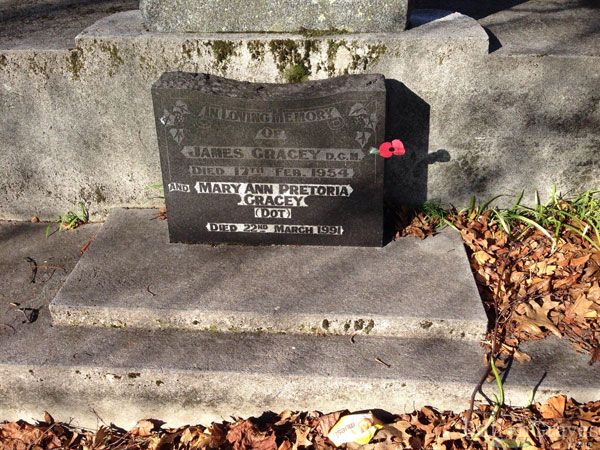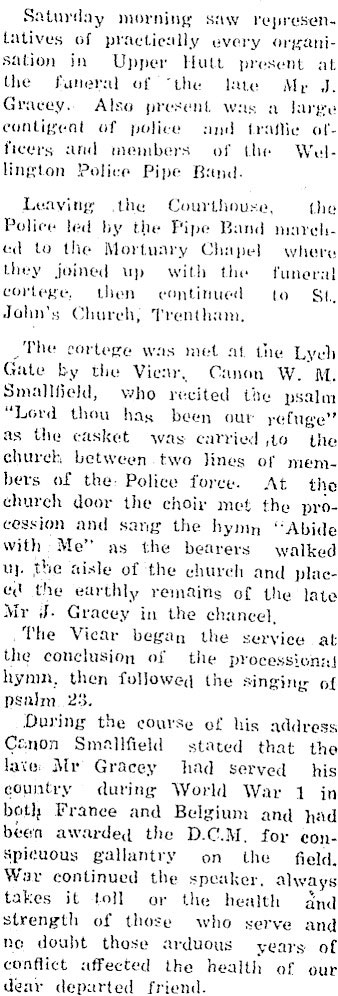Corporal James Gracey, DCM
James Gracey was born at Drumgor, Lurgan, County Armagh, on 4 October 1891, son of carpenter William John Gracey and his wife Margaret Ann Gracey (nee Mathews).
By 1911 he was living at Drumgor with his mother, who was farming, his younger brother George, and his sister Letitia. Both boys were working as factory clerks.
Gracey enlisted in the North Irish Horse between 1 and 3 May 1915 (No.1504). He embarked for France on 17 November that year with F Squadron.
He remained with the squadron over the following two years. In June 1916 it joined with C Squadron and the 6th (Inniskilling) Dragoons Service Squadron to form the 2nd North Irish Horse Regiment. In September the following year the regiment was dismounted and most of its officers and men transferred to the 9th Battalion, Royal Irish Fusiliers (which was then re-named the 9th (North Irish Horse) Battalion).
Gracey was one of a party of around 70 detailed to transport the regiment's horses to Egypt. They left the regiment on 14 August 1917 and after a period in Alexandria and travelling back through Italy, reported for duty with the 9th Battalion at Ruyaulcourt on 5 October. Gracey was issued a new regmental number – 41572.
Over the next year the battalion saw significant action, including at Cambrai (November-December 1917), the German Spring Offensive (March and April 1918), and in the Advance to Victory Offensive (September to November 1918).
On 4 September 1918 at Wulverghem on the Ypres front the 9th Battalion took part in an attack along the Douve River. According to its war diary:
At 8am Battle Headquarters was formed at T.10.d.05.80 and under an artillery barrage the Battalion, in conjunction with other Battalions on flanks, attacked. Good progress was made. D Company lost direction and got as far as Stinking Farm (U.7.a). Not being protected on flanks the enemy attempted to cut them off and the Company had to retire. Our line was established from road (T.6.d.35.80) where touch was made with the 30th Division, along hedge running south through T.6.d.4.0 to (rise?) in T.12.b then along breastwork trench from T.12.c.50.35 – T.18.a.80.90, with the gap between B and A Companies D Company was put in support along road running south through T.6.c and T.12.a. The enemy were not very numerous but their machine gun fire was heavy. The shelling was fairly heavy but was confined to vicinity of St Quentin Cabaret. During the operation Battle Headquarters was moved to T.5.d.80.40. Six prisoners were made, four of whom were sent through 29th Division on the right. Some of our men on the right were cut off and are thought to be made prisoners. The 29th Division took Hill 63 but did not come up far enough to cover our right flank. During the day there was an amount of sniping and machine gun fire and the enemy shelled St Quentin Cabaret and T.12.a with 5.9. In the afternoon he attempted a counter-attack by coming up along railway between B and A Companies, but was driven back by machine gun and rifle fire. At dusk our patrols were pushed forward to get the line behind Bristol Castle but were unable to do so owing to machine gun.
Gracey was one of those rewarded for his actions that day. His Distinguished Conduct Medal citation reads:
For conspicuous gallantry and devotion to duty. After his section commander had been, wounded he took command and led a charge on two enemy machine-gun positions, inflicting heavy casualties on the enemy. Subsequently, though wounded himself, he assisted the stretcher-bearers in bringing in the wounded under heavy machine-gun fire.
On 26 February 1919 he was transferred to Class Z, Army Reserve.
Soon after the war he emigrated to New Zealand, where he joined the police force, serving at Wellington and Upper Hutt until his death on 17 February 1954. He is buried in St John's Anglican Churchyard, Wellington.


Upper Hutt Leader, 25 February 1954
Image sourced from Billion Graves website.
